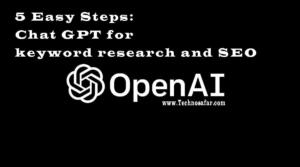What is Artificial Intelligence
Future of Artificial Intelligence (AI): It is a branch of computer science that focuses on creating intelligent machines capable of performing tasks that typically require human intelligence. It involves developing algorithms and models that enable computers to learn from data, reason, make decisions, and solve problems.
AI encompasses various subfields such as machine learning, natural language processing, computer vision, and robotics. Through AI, machines can mimic human cognitive functions and perform tasks like speech recognition, image classification, autonomous driving, and virtual assistants.
Note: The goal of AI is to enhance efficiency, accuracy, and automation in diverse industries while advancing technological capabilities.
➡ Know: 20 Best Useful AI chatbots in 2023 – Types, Examples, Benefits

The Evolution of AI
The evolution of Artificial Intelligence (AI) has been a fascinating journey marked by significant milestones and breakthroughs. Let’s explore the key stages of AI’s evolution:
1.) Early Concepts and Foundations (1950s-1960s):
The term “Artificial Intelligence” was coined in 1956, and early pioneers like Allen Newell, John McCarthy, and Marvin Minsky laid the groundwork for AI research.
The focus was on symbolic reasoning and creating logic-based systems capable of solving problems.
2.) Knowledge-Based Systems (1970s-1980s):
- Expert systems emerged as a dominant AI approach, aiming to replicate human expertise in specific domains.
- These systems utilized knowledge bases and rule-based inference engines to make informed decisions.
- The emphasis was on symbolic AI and rule-based programming languages like LISP and Prolog.
3.) Neural Networks and Machine Learning (1980s-1990s):
- Neural networks gained prominence, inspired by the biological structure of the brain.
- Backpropagation, a learning algorithm for neural networks, allowed them to learn from labeled data.
- Machine learning techniques such as decision trees and support vector machines were also explored.
- AI applications focused on pattern recognition, speech recognition, and computer vision.
4.) Big Data and Deep Learning (2000s-Present):
- The availability of large datasets and advancements in computing power propelled the era of Big Data and deep learning.
- Deep learning models, such as convolutional neural networks (CNNs) and recurrent neural networks (RNNs), achieved remarkable success in various domains.
- Image recognition, natural language processing, and speech synthesis saw significant advancements.
- AI applications expanded into areas like autonomous vehicles, virtual assistants, and recommendation systems.
5.) Cognitive Computing and AI Integration (Present and Future):
- Cognitive computing aims to simulate human-like intelligence by combining AI with other technologies like natural language processing, computer vision, and knowledge representation.
- AI systems like IBM’s Watson demonstrated impressive capabilities in areas like healthcare diagnosis and jeopardy-style game shows.
- AI integration with other emerging technologies, such as the Internet of Things (IoT) and robotics, is creating new possibilities.
- The focus is shifting towards explainable AI, ethical considerations, and ensuring transparency in AI decision-making processes.
6.) Use of the Future of Artificial Intelligence in Real Life
The future of artificial intelligence (AI) holds immense potential for transforming various aspects of real-life applications. Here are some notable areas where AI is expected to make a significant impact:
1.) Healthcare:
AI can revolutionize healthcare by improving diagnostics, personalized medicine, and drug discovery. Machine learning algorithms can analyze medical data to assist in early disease detection, identify patterns, and recommend appropriate treatment plans. AI-powered robots can also assist in surgeries and provide care for the elderly.
2.) Autonomous Vehicles:
The future of transportation lies in AI-driven autonomous vehicles. Self-driving cars equipped with AI systems can enhance road safety, reduce accidents, and optimize traffic flow. These vehicles can make real-time decisions, navigate complex environments, and communicate with other vehicles and infrastructure.
3.) Customer Service:
AI-powered chatbots and virtual assistants are becoming increasingly prevalent in customer service. Natural language processing enables these systems to understand and respond to customer queries, provide personalized recommendations, and handle routine tasks, enhancing overall customer experience.
4.) Finance:
AI has the potential to transform the finance industry by automating processes, detecting fraud, and making data-driven investment decisions. Machine learning algorithms can analyze vast amounts of financial data, predict market trends, and optimize trading strategies, resulting in improved accuracy and efficiency.
5.) Education:
AI can revolutionize education by personalizing learning experiences for students. Intelligent tutoring systems can adapt to individual student needs, provide customized feedback, and track progress. AI can also assist in content creation, automated grading, and identifying areas where students may need additional support.
6.) Manufacturing and Robotics:
AI-powered robots and automation systems can streamline manufacturing processes, improving productivity, and precision. These systems can handle repetitive tasks, perform complex assembly operations, and adapt to changing production requirements.
7.) Cybersecurity:
With the increasing threat of cyber attacks, AI can play a crucial role in enhancing cybersecurity. Machine learning algorithms can analyze patterns, detect anomalies, and identify potential security breaches in real-time, providing proactive defense against cyber threats.
7.) Environmental Sustainability:
AI can contribute to addressing environmental challenges. By analyzing large amounts of data, AI can optimize energy usage, improve resource management, and enable predictive maintenance, resulting in reduced waste and increased sustainability.
8.) Agriculture:
AI can help optimize agricultural practices by monitoring crop health, predicting yields, and managing resources efficiently. Drones equipped with AI can survey large areas, identify plant diseases, and automate spraying or irrigation processes.
9.) Personalized Digital Assistants:
AI-driven digital assistants like Siri, Alexa, or Google Assistant are already prevalent in our lives. These assistants can perform tasks, answer queries, provide recommendations, and integrate with various smart home devices, simplifying daily routines.
Introduction
- Overview of the current state of artificial intelligence (AI)
- Importance of AI in various industries
- A brief history of AI and Its Advancements
I. The Rapid Evolution of Artificial Intelligence
A. Understanding AI: Definitions and Concepts
B. Machine Learning: A Catalyst for AI Growth
- 1. Supervised Learning
- 2. Unsupervised Learning
- 3. Reinforcement Learning
C. Deep Learning: Unleashing the Power of Neural Networks
- 1. Convolutional Neural Networks (CNN)
- 2. Recurrent Neural Networks (RNN)
- 3. Generative Adversarial Networks (GANs)
D. Natural Language Processing (NLP) and AI
E. Computer Vision: The Intersection of AI and Visual Perception
II. AI Revolutionizing Industries
A. Healthcare
- 1. AI-assisted Diagnostics
- 2. Personalized Medicine
- 3. Drug Discovery and Development
B. Finance
- 1. Fraud Detection and Prevention
- 2. Algorithmic Trading
- 3. Risk Assessment and Management
C. Manufacturing and Robotics
- 1. Automation and Efficiency
- 2. Collaborative Robots (Cobots)
- 3. Quality Control and Predictive Maintenance
D. Transportation and Autonomous Vehicles
- 1. Self-driving Cars
- 2. Smart Traffic Management Systems
- 3. Enhanced Safety and Efficiency
E. Education
- 1. Personalized Learning Experiences
- 2. Intelligent Tutoring Systems
- 3. AI-based Student Assessment and Feedback
III. Ethical Considerations and Challenges
- A. Bias and Fairness in AI Systems
- B. Privacy and Security Concerns
- C. Unemployment and the Workforce Shift
- D. Ethical Decision Making and Autonomous AI
- E. Accountability and Transparency in AI Algorithms
IV. The Future of AI: Promising Trends and Possibilities
- A. Quantum Computing and AI
- B. Explainable AI: Understanding AI Decision Making
- C. Human-Machine Collaboration
- D. AI in Space Exploration E. AI and Sustainability: Solving Global Challenges
V. The Road Ahead: Overcoming Barriers to AI Advancement
- A. Continued Research and Development
- B. Collaborative Efforts and Partnerships
- C. Regulatory Frameworks and Ethical Guidelines
- D. Addressing Public Concerns and Misconceptions
- E. Fostering a Skilled Workforce for AI
Positive and Negative Impact of AI
Artificial Intelligence (AI) has both positive and negative impacts on various aspects of society. Let’s explore the positive and negative sides of AI:
Positive Impact of AI
1.) Automation and Efficiency:
AI-driven automation enhances productivity and efficiency by automating repetitive tasks, allowing humans to focus on more complex and creative endeavors. This leads to increased productivity, reduced errors, and cost savings.
2.) Healthcare Advancements:
AI is transforming healthcare with improved diagnostics, personalized medicine, and drug discovery. AI algorithms can analyze medical data, assist in early disease detection, recommend treatment plans, and enhance patient care through telemedicine and remote monitoring.
3.) Enhanced Safety
AI plays a vital role in enhancing safety in various domains. In transportation, AI enables self-driving cars that can potentially reduce accidents and optimize traffic flow. AI-powered systems can also detect and mitigate cybersecurity threats, enhancing overall digital safety.
4.) Personalized Experiences
AI enables personalized experiences in areas like entertainment, marketing, and education. Recommendation systems use AI algorithms to tailor content and product suggestions based on individual preferences, enhancing user satisfaction.
5.) Improved Decision Making
AI helps in data analysis and pattern recognition, enabling data-driven decision-making. AI algorithms can process vast amounts of data quickly, identify trends, and provide valuable insights, leading to better strategic decisions across industries.
Negative Impact of AI
1.) Job Displacement
The automation of tasks by AI can lead to job displacement and unemployment. As AI takes over repetitive and routine tasks, there is a risk of human workers being replaced by machines. It necessitates reskilling and upskilling the workforce to adapt to the changing job landscape.
2.) Privacy Concerns
AI relies on vast amounts of data, raising concerns about data privacy and security. The collection and analysis of personal information by AI systems can lead to potential privacy breaches, data misuse, and surveillance concerns.
3.) Bias and Discrimination
AI algorithms can exhibit biases if trained on biased or incomplete datasets. This can result in discriminatory outcomes, perpetuating societal inequalities. Addressing bias in AI algorithms is crucial to ensure fairness and avoid unintended discrimination.
4.) Ethical Dilemmas
The development of AI raises ethical dilemmas and challenges. Questions arise regarding AI’s impact on human decision-making, accountability for AI-generated decisions, and the potential loss of human control over critical systems.
5.) Dependency and Reliability
Overreliance on AI systems can lead to dependency and vulnerability. Technical failures or malicious manipulation of AI systems can have significant consequences, impacting sectors such as finance, healthcare, and transportation.








